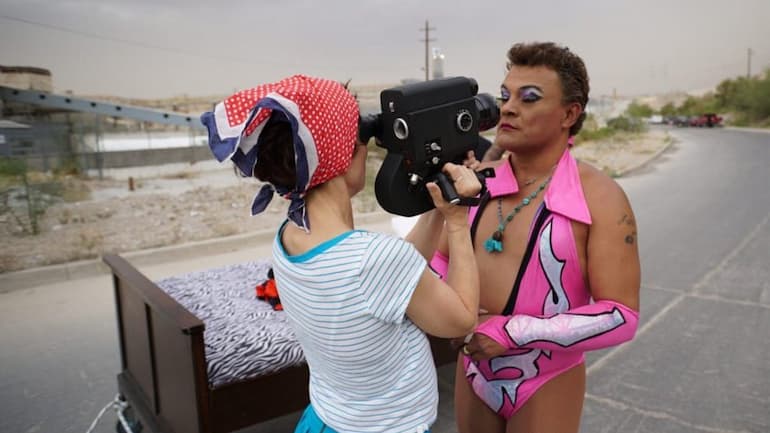Late in Cassandro, The Exotico!, a documentary about Lucha Libre pioneer Saúl Armendáriz, we see Cassandro’s elaborate beaded capes and pink spandex wrestling outfits hanging on the clothesline in the backyard of his plain, modest house.
It’s a scene that captures the essence of this film: moments of wit and lots of color that balance out a dark story of pain and abuse.
I knew very little about Mexican wrestling, (aka: Lucha Libre) prior to viewing Cassandro. Nevertheless, I found the film to be painfully relatable, and a moving depiction of an aging wrestler forced by injuries and ailments to give up the career he loves. With the recent film Cassandro, which tells the story of Cassandro through the acting work of Gael García Bernal, it’s worth revisiting the 2019 documentary that preceded the Hollywood version.
Cassandro, The Exotico! style built around Lucha Libre identity, pompadour style
Directed by Paris-based Marie Losier, Cassandro, The Exotico!, was shot entirely on 16mm film, which created a nostalgic atmosphere from the beginning. Cassandro is an amazingly popular, cross-dressing luchador, who is entering retirement at the age of 47, because of numerous injuries.
The “exotico” subgenre of professional wrestling is a male wrestler who fights/performs in drag. The exotico performs in a silly and campy style, but nonetheless delivers death-defying stunts and acrobatics. Cassandro has endured 20 plus years of this.
Losier chronicles the elaborate process of Cassandro preparing to wrestle (and entertain): his signature pomodoro (or pompadour) style hair is curled and sprayed, glittery drag-queen style makeup is applied, and Cassandro squeezes into a sparkly costume and dons a 12-foot cape fashioned after Princess Diana’s wedding gown.
Difficult childhood affected Cassandro throughout his life
He takes his preparation seriously — and his sobriety. During one home interview, Cassandro proudly displays his 11 years of sobriety and key tags from Narcotics Anonymous.
Born and raised in El Paso, Texas, Cassandro spent much of his formative years just across the border in his family’s native town, Ciudad Juárez. He speaks on the difficulty of straddling two cultures while growing up as an openly gay man. He touches on his home life, including sexual abuse he endured at a very young age.
We learn how Cassandro’s substance abuse numbed his emotional pain, and left him estranged from much of his family. Since becoming sober in 2003, Cassandro has repaired his relationship with his father. He’s often seen praying and meditating throughout the film.
Lucha Libre is like “church” for a young Cassandro, who spent Sunday afternoons with his family watching and imitating the popular, macho luchadores, who wear distinctive face masks that play into their wrestling personas.
Cassandro displays a candid vulnerability, often openly weeping when he talks about his many injuries and years of therapy to deal with emotional traumas. As he is forced to hang up his glittery capes, in one of the final shots we see him hobbling around with a full leg brace, wincing in pain.
His hair has been cropped so even his signature pompadour hairstyle is gone, signifying this really is the end of his career. It’s a stark contrast to the earlier clips of of Cassandro in his prime, featuring the elaborate spectacle of fantasy turned performance—smoothly sailing around the ring, light on his feet and seemingly invincible.
(This article originally appeared in January 2019 and written in advance of Cassandro! the Exotico’s showing at Iowa City’s Pride at FilmScene, a monthly showcase of queer cinema in collaboration with Iowa City Pride.)


